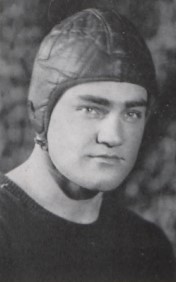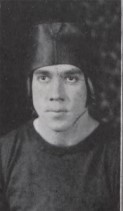LSU Pivotal Football Moments
pivotal college football moment: A decision by a coach or athletic director that changes the momentum of a program or an action by a player that changes the momentum of a game.
pivotal college football moment: A decision by a coach or athletic director that changes the momentum of a program or an action by a player that changes the momentum of a game.
If you were asked, "Who was the first Louisiana governor to give a pep talk to the LSU football team?", you'd probably answer, "Huey Long." But you'd be wrong.
Mike Donahue's first two years as LSU's coach had not lived up to expectations: 3-5-1 in 1923 and 5-4 in 1924. The Tigers' 1925 season would be their first on the new campus in south Baton Rouge. The new stadium had already opened on November 25, 1924 in the final game of the season, a 13-0 loss to Tulane, the Green Wave's fourth victory over the Tigers in the last five matchups.
Donahue counted on some promising newcomers to boost the Tigers in '25, especially QB Lola "Babe" Godfrey from New Mexico Military Academy and HB Everette "Hinky" Haynes from Lineville AL
The season got off to a promising start with victories over Louisiana Normal 27-0 and Southwestern Louisiana 38-0. That cleared the decks for the visit of Wallace Wade's Alabama Crimson Tide to Baton Rouge.
Wade's third Alabama team routed two patsies to start the '25 campaign, defeating Union 53-0 and Birmingham-Southern 50-7. Surely, the Tigers would fare better than those two opponents.
They did fare better but not by much, enduring a 42-0 shellacking in the new Tiger Stadium. The Crimson Tide would defeat all nine opponents in the regular season, not allowing another point after the touchdown by Birmingham-Southern. Their reward would be a Rose Bowl bid against Washington on New Year's Day. In perhaps the most important game in Southern football history, Alabama would defeat the Huskies 20-19.
The Alabama game torpedoed any optimism LSU fans had for the 1925 season and put Donahue squarely on the hot seat. The Tigers needed something easy after that, but they almost didn't get it. In a scrimmage against the freshmen team that is included the school's varsity records, the upperclassmen won by only 6-0.
Next came a trip to Knoxville to play Tennessee. The Volunteers were not yet the perennial powerhouse they would become the following season when General Robert Neyland took the coaching reins. After shutouts against two easy opponents, the Vols lost at Vanderbilt
34-7
34-7
Torrential rain made the playing field for the LSU game "a regular swamp of black, murky mud," to quote the Tennessee 1926 yearbook. Both teams fumbled often, and the game ended in a scoreless tie.
The annual game against Arkansas in Shreveport resulted in a 12-0 defeat for LSU to run their record to 3-2-1.
Governor Gives Pep Talk
Could the Tigers turn their season around against Rice? The 1926 LSU yearbook staff wrote this about the game: "The Rice game neared, and then came the renaissance. Pep meetings were held. Billiken Howell, famed Tiger star and ex-Cheerleader, came back and took charge of things. The business men of Baton Rouge met with the students. Governor Fuqua joined the team in council ..."
Henry Fuqua, an ardent Tiger fan, invited the team to his office. "There's no disgrace in losing when you lose fighting," he told them. "There's glory in such losing, but there's more glory in winning." The governor singled out Red Swanson, LSU's biggest player. "In the right frame of mind, you ought to be able to stop a football team by yourself."
Addressing the entire squad again, Fuqua told them to "get in the right frame of mind. You can beat them all, including Tulane, provided you fight together, keep your heads up, and your minds open."
The entire cadet battalion gathered for a starlight pep rally the night before the Rice game around the flagpole of the Pentagon Barracks, which housed the student body.





L-R: Mike Donahue, Babe Godfrey, Hinky Haynes, Red Swanson, Norman Stevens
(LSU Gumbo Yearbook Class of 1926)
One Pass Breaks Scoreless Deadlock
The Owls' coach was none other than John Heisman, in his second year as head man in Houston. Rice entered the fray with a 4-2 record. Included was a 13-9 triumph over Arkansas two weeks before the Razorbacks beat the Tigers.
As in Knoxville, the game was played "before 3000 fans who stood in the stands while a drenching rain beat down."
The Tigers dominated the first half but had nothing to show for it. Just when everyone was resigned to another scoreless game, LSU struck on one sensational play in the third quarter.
With the ball on Rice's 25, QB Norman Stevens shot a pass to HB Haynes, who dashed the remaining 20y to the end zone. The extra point was missed, which must have left many pessimistic Tiger fans wondering if Rice would prevail 7-6.
Tigers Stifle Rice Passing Attack
The visitors opened the final period with "a desperate passing attack, but their efforts netted not even a single first down in the period." Godfrey, Ben Miller, Swanson, and Haynes led the shutout effort of the Tiger defense.
FINAL SCORE: LSU 7 RICE 0
References
The Louisiana Tigers: LSU Football, Dan Hardesty (1975)
The Fighting Tigers II: LSU Football 1893-1980, Peter Finney (1980)
The Louisiana Tigers: LSU Football, Dan Hardesty (1975)
The Fighting Tigers II: LSU Football 1893-1980, Peter Finney (1980)